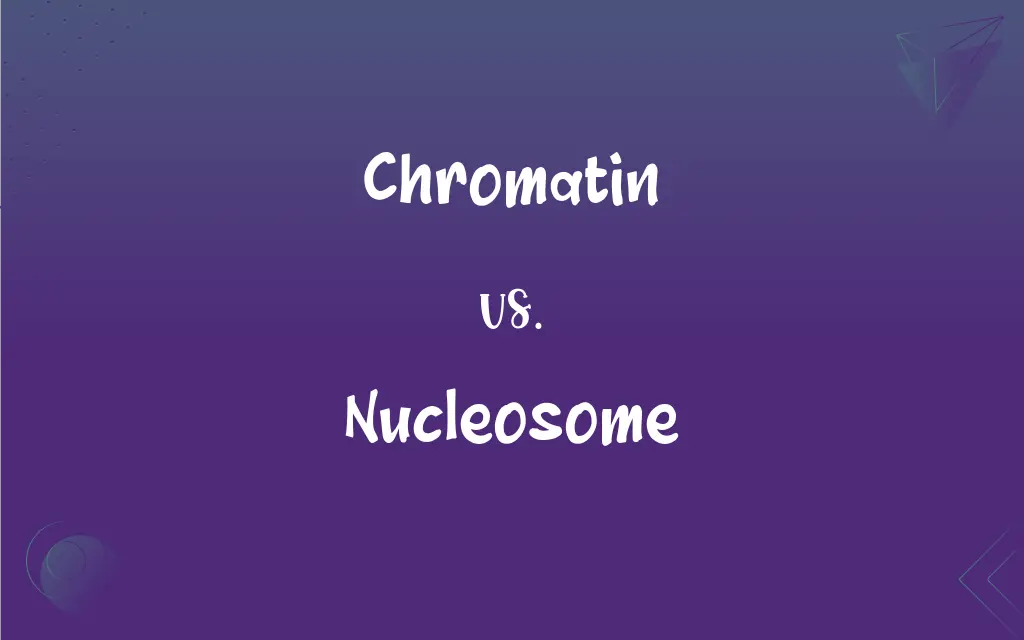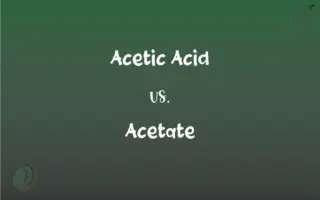Chromatin vs. Nucleosome: What's the Difference?
Edited by Aimie Carlson || By Janet White || Published on December 16, 2023
Chromatin is the complex of DNA and proteins in the cell nucleus, while a nucleosome is the basic unit of DNA packaging in chromatin.

Key Differences
Chromatin is the substance within a chromosome consisting of DNA and protein, whereas a nucleosome is a specific segment of DNA wound around a core of histone proteins within chromatin.
Chromatin organizes the long DNA molecules so they fit into the cell nucleus, while nucleosomes help to supercoil and condense DNA into this chromatin structure.
Chromatin undergoes structural changes during cell division, becoming highly condensed, and nucleosomes are vital components of these chromatin fibers, maintaining their structure.
The composition of chromatin changes depending on the cell cycle, while the nucleosome remains a consistent structural unit within the chromatin, providing stability and regulation for DNA processes.
In chromatin, DNA is associated with different proteins, including histones, while in nucleosomes, DNA is wrapped around a histone octamer, forming a bead-like structure.
ADVERTISEMENT
Comparison Chart
Definition
DNA-protein complex in cell nuclei
Basic unit of DNA packaging in chromatin
Structure
Composed of DNA, histones, and other proteins
DNA segment wound around histone proteins
Function
Organizes and condenses DNA
Helps in supercoiling and stabilizing DNA
Role in Cell Cycle
Undergoes structural changes during division
Maintains structure of chromatin fibers
Relationship with DNA
Encompasses all DNA within the nucleus
A segment of DNA wrapped around histones
ADVERTISEMENT
Chromatin and Nucleosome Definitions
Chromatin
Chromatin undergoes structural modifications to regulate gene expression.
Changes in chromatin structure can affect gene activity.
Nucleosome
It comprises DNA wrapped around a histone octamer.
The nucleosome structure is essential for efficient DNA storage.
Chromatin
It consists of repeating units of DNA wrapped around protein complexes.
The chromatin fiber is visible under a microscope during certain cell stages.
Nucleosome
Nucleosomes compact DNA into the chromatin structure.
Nucleosomes play a crucial role in DNA condensation and regulation.
Chromatin
Chromatin is the complex of DNA and proteins found in a cell's nucleus.
The chromatin structure changes during the process of cell division.
Nucleosome
A nucleosome is the fundamental unit of DNA packaging in eukaryotic cells.
Each nucleosome consists of a segment of DNA wound around eight histone proteins.
Chromatin
Chromatin helps in organizing and compacting DNA within the nucleus.
Scientists study chromatin to understand genetic regulation.
Nucleosome
Nucleosomes allow DNA to be accessible for transcription and replication.
Gene expression is partly regulated by the positioning of nucleosomes.
Chromatin
It exists in two forms: euchromatin (less condensed) and heterochromatin (more condensed).
Euchromatin regions of chromatin are generally more transcriptionally active.
Nucleosome
The spacing of nucleosomes affects chromatin's density and accessibility.
Researchers study nucleosome spacing to understand gene regulation mechanisms.
Chromatin
A complex of nucleic acids and proteins, primarily histones, in the cell nucleus that stains readily with basic dyes and condenses to form chromosomes during cell division.
Nucleosome
Any of the repeating subunits of chromatin found in eukaryotes, consisting of a DNA chain coiled around a core of histones.
Chromatin
(biology) A complex of DNA, RNA and proteins within the cell nucleus out of which chromosomes condense during cell division.
Nucleosome
(genetics) Any of the subunits that repeat in chromatin; a coil of DNA surrounding a core of eight histones.
Chromatin
Tissue which is capable of being stained by dyes.
Chromatin
The deeply staining substance of the nucleus and chromosomes of eukaryotic cells, composed of DNA and basic proteins (such as histones), the DNA of which comprises the predominant physical basis of inheritance. It was, at the beginning of the 20th century, supposed to be the same substance as was then termed idioplasm or germ plasm. In most eukaryotic cells, there is also DNA in certain plasmids, such as mitochondria, or (in plant cells) chloroplasts; but with the exception of these cytoplasmic genetic factors, the nuclear DNA of the chromatin is believed to contain all the genetic information required to code for the development of an adult organism. In the interphase nucleus the chromosomes are dispersed, but during cell division or meiosis they are condensed into the individually recognizable chromosomes. The set of chromosomes, or a photographic representation of the full set of chromosomes of a cell (often ordered for presentation) is called a karyotype.
Chromatin
The readily stainable substance of a cell nucleus consisting of DNA and RNA and various proteins; during mitotic division the chromatin condenses into chromosomes
FAQs
What is chromatin?
Chromatin is the combination of DNA and proteins in the nucleus of a cell.
How does chromatin support genetic function?
Chromatin structures DNA to regulate gene expression and DNA replication.
What is a nucleosome?
A nucleosome is the basic structural unit of DNA packaging in chromatin.
How does chromatin relate to chromosomes?
Chromosomes are made of condensed chromatin.
Can nucleosomes be modified?
Yes, nucleosomes undergo modifications that affect their interaction with DNA.
What proteins are in a nucleosome?
A nucleosome contains histone proteins.
Are there different types of chromatin?
Yes, chromatin can be euchromatin or heterochromatin.
How does chromatin change during cell division?
Chromatin becomes highly condensed during cell division.
Is the number of nucleosomes constant in all cells?
The number varies depending on the amount of DNA and the cell type.
Do nucleosomes exist in prokaryotes?
No, nucleosomes are specific to eukaryotic cells.
What is the 'beads on a string' structure in chromatin?
It refers to the appearance of nucleosomes (beads) connected by DNA (string) in chromatin.
What role do nucleosomes play in gene regulation?
Nucleosomes influence gene regulation by controlling DNA accessibility.
How many DNA base pairs are in a nucleosome?
A nucleosome wraps around approximately 147 base pairs of DNA.
How does chromatin affect DNA replication?
Chromatin structure influences the accessibility of DNA for replication.
How is chromatin studied in the lab?
Chromatin is studied using techniques like microscopy and chromatin immunoprecipitation.
Can chromatin structure be artificially altered?
Yes, researchers can modify chromatin structure in lab settings.
Do environmental factors affect nucleosome arrangement?
Yes, environmental factors can influence nucleosome positioning and histone modifications.
How does chromatin organization change in different cell types?
Chromatin organization varies to accommodate specific gene expression patterns in different cell types.
What is the difference between chromatin and chromosomes?
Chromatin is less condensed, while chromosomes are highly condensed structures formed during cell division.
What is the link between nucleosomes and epigenetics?
Nucleosome positioning and modification play key roles in epigenetic regulation.
About Author
Written by
Janet WhiteJanet White has been an esteemed writer and blogger for Difference Wiki. Holding a Master's degree in Science and Medical Journalism from the prestigious Boston University, she has consistently demonstrated her expertise and passion for her field. When she's not immersed in her work, Janet relishes her time exercising, delving into a good book, and cherishing moments with friends and family.
Edited by
Aimie CarlsonAimie Carlson, holding a master's degree in English literature, is a fervent English language enthusiast. She lends her writing talents to Difference Wiki, a prominent website that specializes in comparisons, offering readers insightful analyses that both captivate and inform.






































































